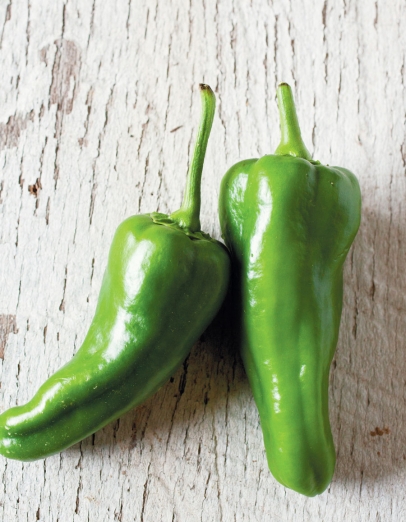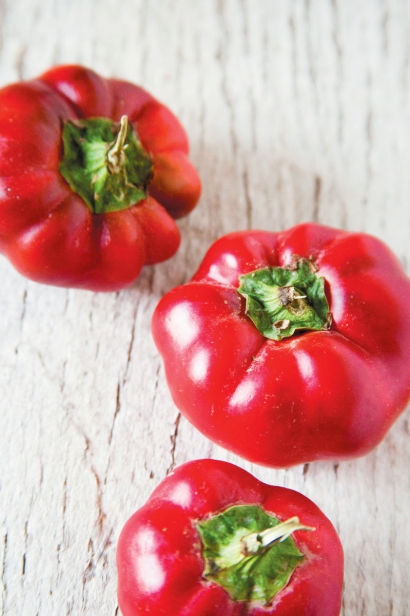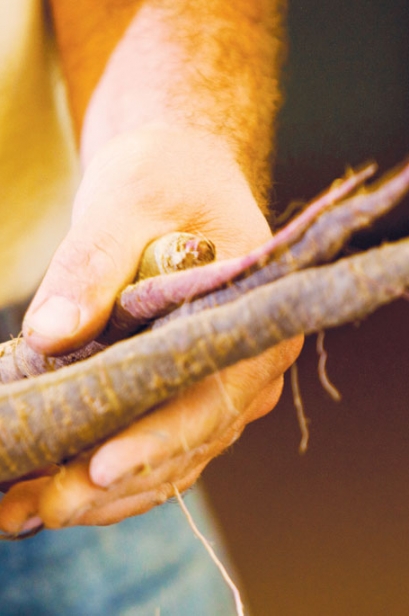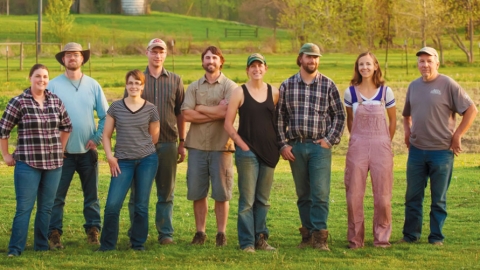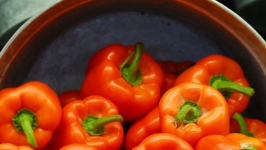A Taste of the Past: GRO's Heirloom Vegetable Varieties Are Rich in Flavor and History
Adam Welly and the farmers of Great River Organics (GRO) are all about preserving and interpreting Ohio’s heritage foods. Meet them at local farmers markets, and their unabashed passion for their farms’ unique produce is evident. They’re on a mission to recruit more fans for some of the state’s most flavorful, colorful, and time-honored produce crops. Adam grew up in Fremont, Ohio, learning that the soil in which you grow food makes a difference in how it tastes.
“The melons from Fremont’s sandy loam just don’t taste the same as ones grown in Central Ohio’s clay soils.” He’s returned home to farm in a region known in the late 1800s to have one of the largest concentrations of vegetable farming in the world. This summer, he invites you to try some of his favorite heirloom vegetables.
Shishito Peppers
Shishito peppers are the Japanese cousin to Spain’s famed Padron peppers. Harvested in late July until frost, these bite-sized mild peppers are a cinch to prepare. Simply toss them in olive oil and char-grill or pan-sear them until their skin blisters, then season them with a pinch of sea salt. Pick them up by the stem and eat them—seeds and all—in one bite. “You’ll enjoy their dark rich flavor, which is similar to a poblano pepper but even more pronounced,” says Adam. “Also, try simmering them in a crock with miso and sesame seeds.”
Sheepnose Pimento Pepper
This ultra-sweet pepper is one of Adam’s all-time favorite things to grow. An Ohio heirloom, the pepper originates from the family of Nick Rini of Hartville. It is one of the 200 heritage foods listed in the Ark of Taste by Slow Food USA. When Wayward Seed Farm first started, Adam discovered this pepper as he was searching the Seed Savers Exchange catalog for Ohio heirlooms to grow. This ended up being one of the first the farm tried. Through GRO, the co-op farmers hope to market the peppers more widely and anticipate great potential for the pepper to become one of the state’s signature crops, much like sweet corn. The peppers average four inches wide and three inches tall. The plants yield a steady supply of peppers until frost. “Try them pickled, canned, stuffed, or baked,” says Adam. “This pepper also makes the best pimento cheese spread.”
Rossa di Milano Onion
“Frankly, Rossa de Milanos are the only onions you need to buy,” says Adam. “They’re not sexy (medium-sized, pale red onions with a gray shallot core), but they’ll make sexy ingredients like Tuscan kale taste even better.” At Wayward, Adam has been growing this onion staple from seed since 2006, and, each year, he saves some seeds for the next season. As a core ingredient for so many recipes, Adam says the Rossa de Milano’s flavor is unrivaled. “When slowly cooked in olive oil, the caramelized onions are pure sugar. When served raw, they are very robust.” The onions are harvested in late August and can be stored until February.
Nelson’s Golden Giant Tomato
This Crayola-yellow, Ohio heirloom tomato is from Nelson Grey of Milan. When other heirlooms crack in the fields after a big rain, these 12-ounce to one-pound meaty tomatoes hold their form. Famed seed collector Al Anderson of Troy, Ohio, gave Wayward its first Nelson Golden Giant seeds, and the farm has since saved and shared seeds with other co-op members. Nelson Golden Giants are very late-ripening from late August until frost. “The best way to eat them is at a cookout,” says Adam. “Slice them on a burger or a BLT.” He also suggests cooking them down in a fresh tomato sauce and tossing them with Italian flat beans.
Hinkelhatz Pepper
Another Ark of Taste entry, this 150-year-old heirloom heralds from Pennsylvania Dutch country. In fact, its German name translates “chicken heart” to describe its size and shape. Adams urges Ohioans to adopt this pepper as their go-to regional hot pepper. Harvested from a two-foot bushy plant in September, the Hinkelhatz has a very unique, tangy hot flavor like a Scotch Bonnet with a bouquet. “Try it pickled, or roasted and purée for an enchilada sauce,” says Adam. “It’s also tailor-made for hot sauces for Bloody Marys.”
Dragon Carrots
West Coast grower John Navazio bred these refined, purple carrots using heirloom stock. “Kids and parents fell in love with them at the markets,” says Adam. “They catch attention, but they’re not just for show—they’re really delicious.” Tests show they’re also nutritious with high levels of anthocyanin and other antioxidants. Adam says Wayward grows the carrots in limited quantities, since their fragile tops can make harvesting difficult. Try cutting them on the diagonal to expose their golden center and roast them with thyme and butter. Also, enjoy their wild, spicy-like flavor in a raw carrot salad.
Calcots
These long, juicy green onions are a seasonal treat from Catalonia, which hosts festivals celebrating their harvest. At these rite-of-spring events, the calcots are grilled over an open fire and served wrapped in paper. Festivalgoers devour the scorched onions by grabbing their green stalks, discarding the blackened roots, and eating the soft white part, either solo or dipped in salsa romesco. Adam says local food connoisseur Jim Budros challenged Wayward to grow them. Through trial and error, the farm learned the fall-planted green onions wouldn’t overwinter in Ohio. Instead, they found the calcots could be successfully planted in the spring for a fall harvest. “The key is the length of the white shank,” says Adam. “The longer the better.” GRO is trying to recreate calcots’ revelry in Central Ohio. One fall day at the North Market, Adam says they started grilling calcots and sold $1,000 worth of the green onions in one day. Capture the revelry in your own backyard by serving these at your next barbeque.
Italian Flat Beans
Don’t be fooled by the size of these flat beans. They’re not unshucked fava or lima beans. Rather, they’re larger green beans that stay tender when lightly sautéed or blanched. GRO farmers cultivate the bean plants in hedge-like rows, which yield “fantastic harvests” in September. These flat beans, also known as Romano beans, can be substituted in any recipe using green beans.
Scorzonera
Some call this unique, Mediterranean root vegetable “black salsify,” or “oyster plant,” since it tastes like an oyster when toasted or stewed. Adam says Wayward decided “to grow the weirdest root crops ever and see what sells.” He says this dandelion-like plant fills the bill with its chicory-like greens and strong root. Scorzonera adds a distinct flavor to fall and winter vegetable soups and stews.
Gilfeather Turnip
Adam argues the Gilfeather Turnip is not a turnip but actually a rutabaga. “It’s not fine in appearance, but fine in flavor,” he says. Wayward started growing this rare, white-rooted vegetable in the farm’s early years to add to its collection of unusual root crops. The plant is named after John Gilfeather of Wardsboro, Vermont, and is a recent addition to Slow Food’s Ark of Taste.
Visit ediblecolumbus.com to learn about the favorite heirloom varieties of the other farmers at GRO.


